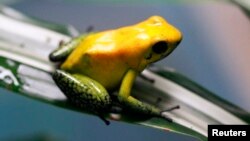Unchecked climate change will cause widespread global loss of plants and animals, according to a new study of 50,000 common species. It's the most comprehensive analysis ever done of global warming's potentially calamitous impact on biodiversity.
The study looks at plant and animal losses in a world that is four degrees Celsius warmer than in pre-industrial days. Under this scenario, the report predicts dramatic declines by the end of this century, according to lead author Rachel Warren, associate professor of climate research at the University of East Anglia in Britain.
“And we found that if there is no action to reduce the emissions of greenhouse gases, that more than half of the plants and one third of the animals would lose more than half of their climatic range,” said Warren.
Warren said if nothing is done to stop or slow the warming, biodiversity would be impacted almost everywhere.
“And we found those losses were greater, although they are quite large everywhere, the biggest losses were in Sub-Saharan Africa, Central America, Amazonia, Australia, North Africa, Central Asia and southeast Europe,” she said.
So picture a world where common species like cocoa beans, coffee or frogs have become rare or endangered. Warren said even small losses in global biodiversity can significantly harm ecosystems and the life-support services they provide.
“These are things like the purification of water and air, the cycling of nutrients, which is very important for our agriculture, pollination, the provision of food and fuel for societies that depend on the land. Flood control and soil erosion, all of these are affected by ecosystems,” she said.
The study results did not calculate the effect of other symptoms of climate change - such as frequency and intensity of extreme weather events, pests and diseases - which means, Warren said, that the estimates reported in the paper could be even greater.
But the report does calculate the benefit of action. Warren said if, for example, in a world where greenhouse gases peak in 2016, followed by annual global reductions between two to five percent a year…
“In that scenario we found that we could avoid 60 percent of these range losses," added Warren. "We then compared that with a situation where emissions peaked in 2030 and then were reduced at 5 percent annually and found that we could still avoid 40 percent of the losses.”
The fact is, however, that greenhouse gas emissions keep climbing. The National Oceanic and Atmospheric Administration announced last week that the average daily concentration of carbon dioxide in the atmosphere had reached 400 parts per million, aggravating the impact of climate change.
“The emissions are currently increasing at a rate that slightly exceeds that in our 4 degrees [warmer] scenario, in fact,” she said.
Rachel Warren said the study makes clear the need to reduce emissions. The alternative, the paper concludes, “is a world with an impoverished biosphere where ecosystems have been eroded to the detriment of agriculture and human well-being.”
The study looks at plant and animal losses in a world that is four degrees Celsius warmer than in pre-industrial days. Under this scenario, the report predicts dramatic declines by the end of this century, according to lead author Rachel Warren, associate professor of climate research at the University of East Anglia in Britain.
“And we found that if there is no action to reduce the emissions of greenhouse gases, that more than half of the plants and one third of the animals would lose more than half of their climatic range,” said Warren.
Warren said if nothing is done to stop or slow the warming, biodiversity would be impacted almost everywhere.
“And we found those losses were greater, although they are quite large everywhere, the biggest losses were in Sub-Saharan Africa, Central America, Amazonia, Australia, North Africa, Central Asia and southeast Europe,” she said.
So picture a world where common species like cocoa beans, coffee or frogs have become rare or endangered. Warren said even small losses in global biodiversity can significantly harm ecosystems and the life-support services they provide.
“These are things like the purification of water and air, the cycling of nutrients, which is very important for our agriculture, pollination, the provision of food and fuel for societies that depend on the land. Flood control and soil erosion, all of these are affected by ecosystems,” she said.
The study results did not calculate the effect of other symptoms of climate change - such as frequency and intensity of extreme weather events, pests and diseases - which means, Warren said, that the estimates reported in the paper could be even greater.
But the report does calculate the benefit of action. Warren said if, for example, in a world where greenhouse gases peak in 2016, followed by annual global reductions between two to five percent a year…
“In that scenario we found that we could avoid 60 percent of these range losses," added Warren. "We then compared that with a situation where emissions peaked in 2030 and then were reduced at 5 percent annually and found that we could still avoid 40 percent of the losses.”
The fact is, however, that greenhouse gas emissions keep climbing. The National Oceanic and Atmospheric Administration announced last week that the average daily concentration of carbon dioxide in the atmosphere had reached 400 parts per million, aggravating the impact of climate change.
“The emissions are currently increasing at a rate that slightly exceeds that in our 4 degrees [warmer] scenario, in fact,” she said.
Rachel Warren said the study makes clear the need to reduce emissions. The alternative, the paper concludes, “is a world with an impoverished biosphere where ecosystems have been eroded to the detriment of agriculture and human well-being.”






